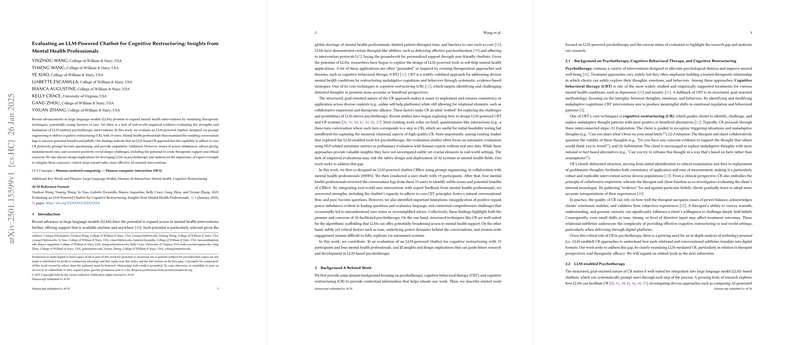The paper presents a comprehensive evaluation of an LLM-powered chatbot—referred to as CRBot—for delivering a cognitive restructuring (CR) intervention in the context of psychotherapy. The paper leverages prompt engineering techniques with few-shot examples and system prompts designed in collaboration with mental health professionals (MHPs) to guide GPT-4’s responses via the Azure OpenAI Service. The evaluation methodology is multifaceted, combining a user paper with 19 participants and an expert review of conversation logs by four seasoned MHPs. The paper is methodologically rigorous and emphasizes both quantitative conversational data and qualitative thematic analysis to derive nuanced insights.
Study Design and Implementation
- Co-Design with Experts:
The chatbot was co-designed in iterative sessions with five MHPs who brought an average of 15 years of clinical counseling experience. The design process employed a think-aloud protocol during Zoom sessions, ensuring that the prompt inputs for CR guidance were aligned with established cognitive behavioral therapy (CBT) protocols. This method ensured that CRBot’s dialogue maintained fidelity to the structured phases of CR—exploration, evaluation, and substitution.
- User Study:
A controlled field paper involved 19 participants (balanced demographics and a range of PHQ-9 and GAD-7 scores indicating none-to-moderate distress) interacting with CRBot. Conversation transcripts were recorded, and descriptive statistics indicate variability in engagement (user messages averaging 7.6 per session and a wide range in word count). Safety measures were embedded in the paper design, including user disclaimers, suicidal ideation detection (with noted prior performance of 82% accuracy in detection), a monitoring dashboard for high-risk interactions, and active human oversight by MHPs.
Evaluation and Findings
- Protocol-Adherence and Conversational Naturalness:
Expert reviewers unanimously noted that CRBot successfully adhered to the core cognitive restructuring phases. The system was able to pose well-timed Socratic questions that align with evidence-based CR practices and maintain a conversational flow that mirrors human therapeutic interactions. For instance, experts remarked on the system’s ability to prompt critical self-reflection without overtly labeling the phases, allowing for a more organic therapeutic dialogue.
- Language Use: Positive Regard and Its Pitfalls:
While CRBot demonstrated proficiency in providing validation and empathy, the experts highlighted instances of “toxic positivity.” Excessive and formulaic positive affirmations (e.g., repetitive use of phrases such as “That’s great!”) were flagged as potentially undermining user authenticity and misaligning with the subtleties required for effective emotional validation. This overuse of effusive praise was seen as a potential trigger for power imbalances and inadvertent judgment.
- Power Dynamics in Conversational Guidance:
The evaluation uncovered that the chatbot’s reliance on leading questions and evaluative language could inadvertently reinforce a power differential. Although structured guidance is inherent in CR interventions, the experts cautioned that when the system preempts or leads the user to a “correct” response, it might diminish the client’s sense of agency. Additionally, evaluative language that mirrors performance assessment rather than collaborative exploration was critiqued.
- Contextual Misinterpretation and Subjectivity:
A significant limitation identified was CRBot’s occasional misinterpretation of user input. Experts noted several instances where the chatbot misread subtle linguistic cues (for example, treating “maybe” as a definitive affirmation) or oversimplified emotional states (e.g., summarizing “embarrassment” as “tough”). This lack of deep contextual understanding can lead to overly reductionist interventions that potentially derail the therapeutic process. The system’s failure to consider session-wide behavioral patterns was particularly concerning, as it did not adapt to signs of disengagement or shifting emotional states.
Discussion and Implications
- Scalability and Modality Considerations:
The paper underscores that while the structured nature of CR makes it amenable to LLM-based delivery, broader applicability to less structured interventions (e.g., cognitive defusion in Acceptance and Commitment Therapy) remains uncertain. The authors advocate for future research to explore the flexibility of LLMs in handling a diverse range of psychotherapeutic modalities that require dynamic and context-sensitive approaches.
- Design Refinements:
Detailed design implications are provided. These include tuning the language style to better emulate authentic therapeutic communication, incorporating multi-modal inputs (such as paralinguistic cues) or iterative confirmatory questioning to deepen contextual understanding, and establishing robust ethical safeguards. The need for reinforcement learning from human feedback is also discussed as a potential strategy to mitigate issues related to advice-giving and misinterpretation.
- Ethical and Practical Safeguards:
Given the potential for iatrogenic outcomes, especially in scenarios involving suicidal ideation or overly directive advice, the paper emphasizes the necessity of continuous expert oversight. The integration of advanced safeguard mechanisms is recommended to detect implicit risk factors and ensure that the system’s interventions do not inadvertently harm users.
Conclusion
The evaluation reveals that while an LLM-powered chatbot can competently deliver a protocol-adherent and conversational CR intervention, critical challenges remain. These include the risks of toxic positivity, inadvertent reinforcement of power differentials, and limitations in nuanced contextual understanding. The work provides detailed insights and design recommendations crucial for advancing the safe and efficacious implementation of AI-assisted psychotherapy. The findings thus contribute both to the technical development of LLM-based mental health tools and to the clinical discourse surrounding their ethical deployment in therapeutic settings.
